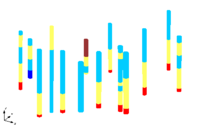GMS:Converting Borehole Data: Difference between revisions
From XMS Wiki
Jump to navigationJump to search
No edit summary |
No edit summary |
||
| Line 6: | Line 6: | ||
*[[GMS:Horizons to 3D Mesh|Horizons to 3D Mesh]] | *[[GMS:Horizons to 3D Mesh|Horizons to 3D Mesh]] | ||
*Contacts to TIN | *Contacts to TIN | ||
<blockquote> | |||
The '''Contacts → TIN''' command is used to create a [[GMS:TIN Module|TIN]] surface from a set of selected contacts.</blockquote> | |||
*Contacts to 2D Scatter Points | *Contacts to 2D Scatter Points | ||
<blockquote>A set of selected contacts can be converted to a 2D scatter point set using the '''Contacts → 2D Scatter Points''' command.</blockquote> | |||
*Sample Data to 3D Scatter Points | *Sample Data to 3D Scatter Points | ||
<blockquote>The '''Sample Data → 3D Scatter Points''' command brings up the ''Sample Data → Scatter Points'' dialog that is used to create a 3D scatter point set from sample data.</blockquote> | |||
*Sample Data to Stratigraphy | *Sample Data to Stratigraphy | ||
*Watertable to 2D Scatter Points | *Watertable to 2D Scatter Points | ||
<blockquote>The water table coordinates for a set of boreholes can be converted to a 2D scatter point set using the '''Water Table → 2D Scatter Points''' command.</blockquote> | |||
*Add Contacts to TIN | *Add Contacts to TIN | ||
<blockquote>The '''Add Contacts to TIN''' command is used to enter a point from a contact into the active TIN. The contact(s) are first selected and the command is then chosen from the ''Borehole'' menu. Typically all contacts which should be part of a TIN are selected before generating the TIN, but sometimes one is inadvertently left out, or more boreholes are added later.</blockquote> | |||
{{Navbox GMS}} | {{Navbox GMS}} | ||
[[Category:Boreholes]] | [[Category:Boreholes]] | ||
